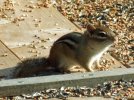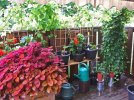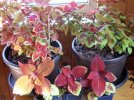Rose and Thistle Custom
Josh Mead
- Joined
- May 9, 2018
- Messages
- 2,301
Most of the ice melted out of my lake today and some of my bushes have tiny buds that, hopefully, will become leaves soon.
The little vegie garden. It changes daily. The white and purple flowers are Columbine (not a native variety). They spread a good bit and I have to try to control the spread. Not really what I want in a limited space vegie garden. The ladder is for the cats to climb back off the garage roof. They can climb up there from a tree (with a bit of a leap) but can't get back. Hence the ladder. ----
The green plants in the background to the left side is Solomon's Seal that has pretty much spread and filled this space. There used to be Azalea's there but they died years ago.
View attachment 1110255
Most of the ice melted out of my lake today and some of my bushes have tiny buds that, hopefully, will become leaves soon.

More snow... ugh. Spring is coming. My lawn looks real good in the spring and fall but doesn't like the hottest part of the summer.Green, green grass - holy cow - looking good. Encouraging. We have had a few inches of snow overnight but wind is not so bad.
Now, in past, I've taught a couple of my dogs to climb a ladder. Can's say I've seen a cat going down one
The wild columbine here is a shade plant and a gem to find growing. Also, here we have false Solomon's seal - great foliage, flowers and red berries, liking dappled to deep shade.
What diameter are those big tomato planters. Looks like plenty of soil for root growth. Garden looks great - so nice to see planting.
Hey, that's over 10 cm of snow in Canadian - snowed under!4 inches of snow yesterday
Glad I could bring my flowers in the garage .Hey, that's over 10 cm of snow in Canadian - snowed under!
The Pansies would have been okay left outside. They are very hardy. Cold slows the growth down, but generally does not kill it unless it's extreme cold.Glad I could bring my flowers in the garage .
Only planted them a few day's before , not a big deal to move them was more worried about the wind .The Pansies would have been okay left outside. They are very hardy. Cold slows the growth down, but generally does not kill it unless it's extreme cold.
Only planted them a few day's before , not a big deal to move them was more worried about the wind .
Interesting question really..... wind chill affecting plants? My brother in law (the horticulturalist and former nursery owner) says "Yes". But wind chill is calculated for people (warm blooded) and not plants. So, I don't know. But I do know that you need to protect plants you might be transporting in say a pickup from extreme exposure to wind (wind burn).Yeah, I've lost many plants in the strong spring sunshine ... but with the freeze in the wind. Sort of why our warnings about frostbite increase with the wind velocity in winter. Nasty winds lately.
Interesting question really..... wind chill affecting plants? My brother in law (the horticulturalist and former nursery owner) says "Yes". But wind chill is calculated for people (warm blooded) and not plants. So, I don't know. But I do know that you need to protect plants you might be transporting in say a pickup from extreme exposure to wind (wind burn).
Added: I decided to just stand the tomato cages over bell pepper plants for the time being. Sometimes when things get a bit grown, some support might be a good thing for them. I can always remove them later. Last year, I had a bell pepper plant that was a bit shaded and it grew 5 feet tall and I supported it with a tomato cage.
... Sounds like a commercial operation. That said, as a kid we had a very large garden space and planted about 100 tomato plants a year. We canned the tomatoes. Yeah. We ate lots of spaghetti. Lots of kids.For several years I did up to 120 tomato and 60 jalapeno plants a year in my greenhouse, all in cut down 5 gallon buckets with drain holes drilled in the bottom.
They also called Quaker parrots. I own a 17 year old Green Quaker and she demands a treat every time I have breakfast or dinner and she can hear me open the fridge Lol. I hear their is a huge flock that live year round in central park NYC. The word is they escaped from a shipment in port and took up residence in the park. Very hearty birds and fun to watch.They are pretty loud and obnoxious birds but they are cool , in the summer they sit right over us and demand food our fault for feeding them .



